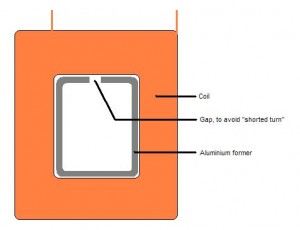Julio Costa <[email protected]> has written a simple program in Visual Basic to help him with the counting of the turns on each of the coils.
“Rather than building an electronic counter, I’ve implemented it in software, so if one has a laptop (or any computer having a printer port) where they are winding the coils, this may be useful.
It works as follows:
The number of turns on each coil is first entered.
It displays a nice big indication of the number of turns left.
It also reads out key numbers using computer-generated speech, so one may concentrate on the task at hand.
It can also automatically stop the coil winder motor (if required) when the required number of turns are complete.
It needs a simple connection of a microswitch and resistor to the printer port (I will include the drawing for this)
One may also then add a relay or triac circuit to start and stop the motor, but this is not essential, although the output for this is provided on the printer port. I will also send the diagram for this.
If you want the program and drawings you are welcome to them, and you may share them with anyone who may be interested.”
 Julio Costa <[email protected]> in South Africa 082 372-1750.
Julio Costa <[email protected]> in South Africa 082 372-1750.


A few years ago, i was attempting to rewind a Jacobs wind turbine. I made a counter from a hand-held, button-push, electronic counter that I got at Radio Shack. Since I’m writing from Canada, I don’t know whether you guys have Radio Shacks but a similar gadget could be bought somewhere lese, I’m sure. Anyway, this unit had an input jack for a 12vdc signal which would advance the counter.
So, I wired a very simple loop consisting of 9 volt battery (it didn’t really need 12 volts) and an infrared photo emitter/detector. I painted part of my shaft white and the rest, black. Every time the shaft turned, the counter advanced.
About the Jacobs…the field coils turned out fine but the armature had shorts. Did it twice…fewer shorts the second time. We thought they might have been caused by solder bridges at the commutator. Conclusion: DC armatures are a real challenge unless one has a mentor that keeps a close eye on what they’re doing. One day, I’ll take it to a shop because removing 600lbs of steel and copper from the top of a tower, to rewind it yet again, when something that “slipped by” decides to act up is not my idea of entertainment. Murphy’s law says that your wind generator will always fail during a spell of the ugliest weather your area has ever experienced.